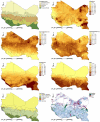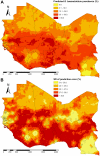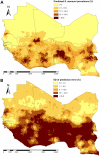Geostatistical model-based estimates of Schistosomiasis prevalence among individuals aged ≤ 20 years in West Africa
- PMID: 21695107
- PMCID: PMC3114755
- DOI: 10.1371/journal.pntd.0001194
Geostatistical model-based estimates of Schistosomiasis prevalence among individuals aged ≤ 20 years in West Africa
Abstract
Background: Schistosomiasis is a water-based disease that is believed to affect over 200 million people with an estimated 97% of the infections concentrated in Africa. However, these statistics are largely based on population re-adjusted data originally published by Utroska and colleagues more than 20 years ago. Hence, these estimates are outdated due to large-scale preventive chemotherapy programs, improved sanitation, water resources development and management, among other reasons. For planning, coordination, and evaluation of control activities, it is essential to possess reliable schistosomiasis prevalence maps.
Methodology: We analyzed survey data compiled on a newly established open-access global neglected tropical diseases database (i) to create smooth empirical prevalence maps for Schistosoma mansoni and S. haematobium for individuals aged ≤ 20 years in West Africa, including Cameroon, and (ii) to derive country-specific prevalence estimates. We used Bayesian geostatistical models based on environmental predictors to take into account potential clustering due to common spatially structured exposures. Prediction at unobserved locations was facilitated by joint kriging.
Principal findings: Our models revealed that 50.8 million individuals aged ≤ 20 years in West Africa are infected with either S. mansoni, or S. haematobium, or both species concurrently. The country prevalence estimates ranged between 0.5% (The Gambia) and 37.1% (Liberia) for S. mansoni, and between 17.6% (The Gambia) and 51.6% (Sierra Leone) for S. haematobium. We observed that the combined prevalence for both schistosome species is two-fold lower in Gambia than previously reported, while we found an almost two-fold higher estimate for Liberia (58.3%) than reported before (30.0%). Our predictions are likely to overestimate overall country prevalence, since modeling was based on children and adolescents up to the age of 20 years who are at highest risk of infection.
Conclusion/significance: We present the first empirical estimates for S. mansoni and S. haematobium prevalence at high spatial resolution throughout West Africa. Our prediction maps allow prioritizing of interventions in a spatially explicit manner, and will be useful for monitoring and evaluation of schistosomiasis control programs.
Conflict of interest statement
The authors have declared that no competing interests exist.
Figures






References
-
- WHO. Prevention and control of schistosomiasis and soil-transmitted helminthiasis: report of a WHO expert committee. WHO Tech Rep Ser. 2002;912:1–57. - PubMed
-
- Steinmann P, Keiser J, Bos R, Tanner M, Utzinger J. Schistosomiasis and water resources development: systematic review, meta-analysis, and estimates of people at risk. Lancet Infect Dis. 2006;6:411–425. - PubMed
-
- King CH, Dickman K, Tisch DJ. Reassessment of the cost of chronic helmintic infection: a meta-analysis of disability-related outcomes in endemic schistosomiasis. Lancet. 2005;365:1561–1569. - PubMed
Publication types
MeSH terms
LinkOut - more resources
Full Text Sources

